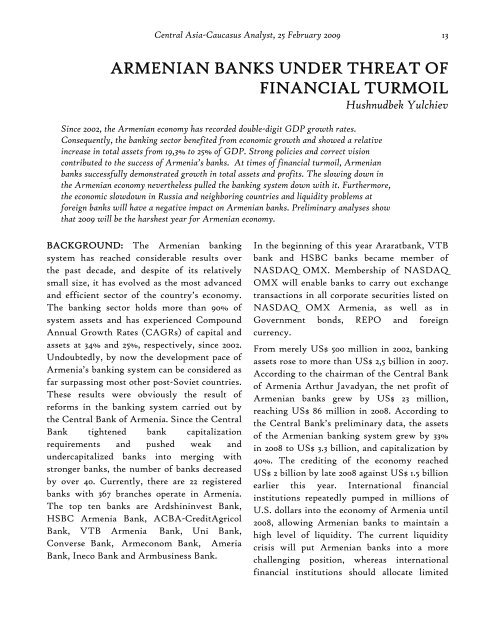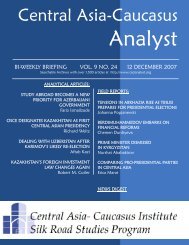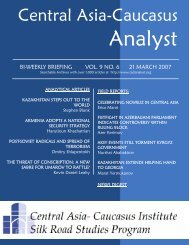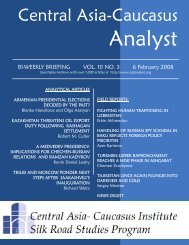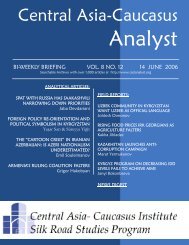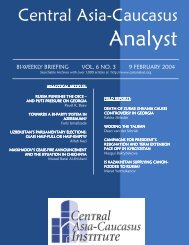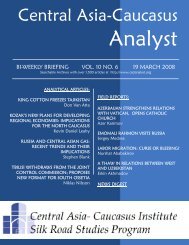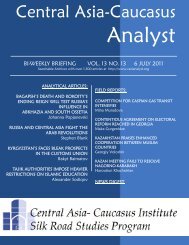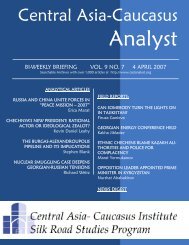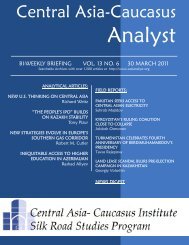Central Asia-Caucasus - The Central Asia-Caucasus Analyst
Central Asia-Caucasus - The Central Asia-Caucasus Analyst
Central Asia-Caucasus - The Central Asia-Caucasus Analyst
You also want an ePaper? Increase the reach of your titles
YUMPU automatically turns print PDFs into web optimized ePapers that Google loves.
<strong>Central</strong> <strong>Asia</strong>-<strong>Caucasus</strong> <strong>Analyst</strong>, 25 February 2009 13<br />
ARMENIAN BANKS UNDER THREAT OF<br />
FINANCIAL TURMOIL<br />
Hushnudbek Yulchiev<br />
Since 2002, the Armenian economy has recorded double-digit GDP growth rates.<br />
Consequently, the banking sector benefited from economic growth and showed a relative<br />
increase in total assets from 19,3% to 25% of GDP. Strong policies and correct vision<br />
contributed to the success of Armenia’s banks. At times of financial turmoil, Armenian<br />
banks successfully demonstrated growth in total assets and profits. <strong>The</strong> slowing down in<br />
the Armenian economy nevertheless pulled the banking system down with it. Furthermore,<br />
the economic slowdown in Russia and neighboring countries and liquidity problems at<br />
foreign banks will have a negative impact on Armenian banks. Preliminary analyses show<br />
that 2009 will be the harshest year for Armenian economy.<br />
BACKGROUND: <strong>The</strong> Armenian banking<br />
system has reached considerable results over<br />
the past decade, and despite of its relatively<br />
small size, it has evolved as the most advanced<br />
and efficient sector of the country’s economy.<br />
<strong>The</strong> banking sector holds more than 90% of<br />
system assets and has experienced Compound<br />
Annual Growth Rates (CAGRs) of capital and<br />
assets at 34% and 25%, respectively, since 2002.<br />
Undoubtedly, by now the development pace of<br />
Armenia’s banking system can be considered as<br />
far surpassing most other post-Soviet countries.<br />
<strong>The</strong>se results were obviously the result of<br />
reforms in the banking system carried out by<br />
the <strong>Central</strong> Bank of Armenia. Since the <strong>Central</strong><br />
Bank tightened bank capitalization<br />
requirements and pushed weak and<br />
undercapitalized banks into merging with<br />
stronger banks, the number of banks decreased<br />
by over 40. Currently, there are 22 registered<br />
banks with 367 branches operate in Armenia.<br />
<strong>The</strong> top ten banks are Ardshininvest Bank,<br />
HSBC Armenia Bank, ACBA-CreditAgricol<br />
Bank, VTB Armenia Bank, Uni Bank,<br />
Converse Bank, Armeconom Bank, Ameria<br />
Bank, Ineco Bank and Armbusiness Bank.<br />
In the beginning of this year Araratbank, VTB<br />
bank and HSBC banks became member of<br />
NASDAQ OMX. Membership of NASDAQ<br />
OMX will enable banks to carry out exchange<br />
transactions in all corporate securities listed on<br />
NASDAQ OMX Armenia, as well as in<br />
Government bonds, REPO and foreign<br />
currency.<br />
From merely US$ 500 million in 2002, banking<br />
assets rose to more than US$ 2,5 billion in 2007.<br />
According to the chairman of the <strong>Central</strong> Bank<br />
of Armenia Arthur Javadyan, the net profit of<br />
Armenian banks grew by US$ 23 million,<br />
reaching US$ 86 million in 2008. According to<br />
the <strong>Central</strong> Bank’s preliminary data, the assets<br />
of the Armenian banking system grew by 33%<br />
in 2008 to US$ 3.3 billion, and capitalization by<br />
40%. <strong>The</strong> crediting of the economy reached<br />
US$ 2 billion by late 2008 against US$ 1.5 billion<br />
earlier this year. International financial<br />
institutions repeatedly pumped in millions of<br />
U.S. dollars into the economy of Armenia until<br />
2008, allowing Armenian banks to maintain a<br />
high level of liquidity. <strong>The</strong> current liquidity<br />
crisis will put Armenian banks into a more<br />
challenging position, whereas international<br />
financial institutions should allocate limited


